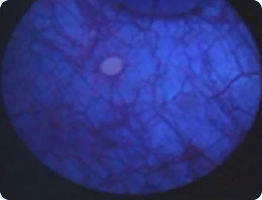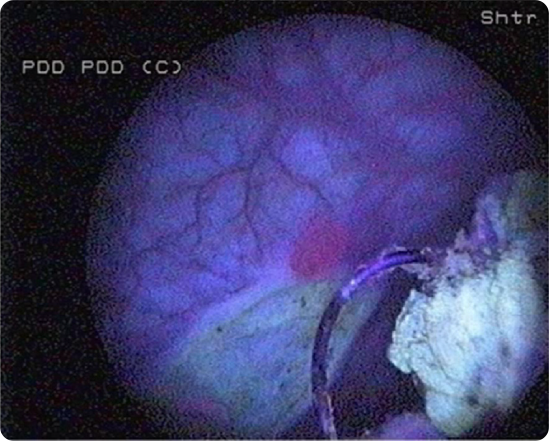Weak fluorescence
- Equipment failure or
- Blood in the bladder or
- Inadequate time or
- Air bubbles or
- Concealed tumours
- Make sure equipment is working and connected properly
- If blood is present, remove resectoscope and flush using a bladder syringe attached to the trocar
- Ensure that Hexvix® was instilled 1 hour prior to cystoscopy
- Remove any air bubbles
- Look behind any folds
No fluorescence
- The equipment has not been set up correctly or
- Blue Light is not activated
- No malignant activated lesions
- Ensure you are using correct equipment; look for blue or violet marker
- Make sure Hexvix® has been instilled, and check for fluorescence in bladder neck
- Inspect light source; original light bulb?

Green hue
- Urine in the bladder
- Always drain the bladder at start of the procedure
- Remove resectoscope, set trocar valve to exit position, and allow urine to drain passively
Entire bladder appears red under white and blue light
- Recent Bacillus Calmette-Guerin treatment or inflammation
- If clinically feasible, avoid BLC® with Hexvix® until 6 weeks after last BCG treatment and in patients with bladder infection
- Either continue procedure without the benefit of Blue Light diagnosis or reschedule
Photo bleaching
- Prolonged use of blue light
- Blue light too close to lesion during procedure
- Alternate between white light and blue light. If the tumour is visible in white light, use BLC® with Hexvix® for control after resection
- Do not use Blue Light close to the tumour for extended time periods. If photo bleaching appears, shut off the blue light and work elsewhere
- Mark small lesions early during procedure
Uncertainty around a large pink/red area
Direct scope 90° toward lesion. Fill bladder slightly. Stretch area with loop and see if it disappears
Questions:
Has a cytology been taken? Were bacterial cultures taken? Has patient used catheter for longer periods?
Is CIS suspected?Cold cup biopsy and no fulguration
Did the patient have a positive urine cytology? Treat as carcinoma in situ
Trouble finding orifice or suspicion that orifice might have been resected

Images courtesy of Professor Malmström, Uppsala University

To avoid false-negative diagnoses
Ensure adequate time after instillation of Hexvix®
Pink fluorescence on bladder neck should always be seen if the instillation was administered properly

Images courtesy of Dr. Sia Daneshmand, Keck Hospital, USC
Bladder neck
Fluorescence is considered normal and not necessarily tumour







